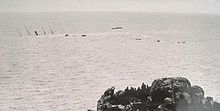SS Mohegan
She was built for 'safety at sea' and was equipped with eight watertight bulkheads, failsafe lighting and pumping systems, eight lifeboats capable of carrying 59 passengers each and three compasses.The passengers protested to the company about the poor condition of the ship, but also reported "the splendid conduct of the officers and crew."Bound for New York, Mohegan sailed from Tilbury Docks at 2:30pm on 13 October 1898, under the command of the 42-year-old Captain Richard Griffith.James Hill, coxswain of the Porthoustock lifeboat, saw the ship's lights and realised that its course would take it onto The Manacles rocks.[2][3] The crew were finally alerted now to the danger, whether by the signals from shore or by the 'old Manacle bell' from the buoy, and the engines were stopped at 6:50 PM, but too late.Captain Griffith had ordered the fitting of a high second rail inboard of the lifeboats to prevent their being rushed in the event of an emergency, but this now hampered the launching of the boats.[2][3][4] Most of the recovered bodies of the drowned were buried in a mass grave in St Keverne churchyard, which was given a memorial stained glass window by the Atlantic Transport Line.The third officer, 30-year-old William Logan Hindmarsh, is buried in the graveyard in Coverack, with an inscription indicating that the boat company paid for his gravestone and interment.The wreck of the Mohegan, and in the next year the stranding of the ocean liner SS Paris on Lowland point, led to the introduction of the Coverack lifeboat.The sinking was the greatest disaster in the history of the Atlantic Transport Line to date, and occurred in mysterious circumstances, as the ship had steered some distance off course.


Atlantic Transport LineLizard PeninsulaThe ManaclesLloyd's of Londonbulkheadscompassestroop transportsUnited States governmentSpanish–American WarBoadiceaWinifredaBoard of TradeTilbury DocksantimonyGravesendEnglish ChannelCornwallEddystone LighthouseFalmouthHelford RiverThe LizardCoverackcoxswainPorthoustock lifeboatstarboardquartermasterRNLI Silver MedalSt KeverneWilliam McGonagallocean linerSS ParisCoverack lifeboatShipwrecksActiveKoonyaClara NevadaVeendamUSS MaineEliza AndersonCastillaDon Antonio de UlloaDon Juan de AustriaIsla de LuzónMarques del DueroReina CristinaVelascoHerewardMerksworthAdelaideUSS MerrimacAlmirante OquendoCristóbal ColónInfanta Maria TeresaPlutónVizcayaLa BourgogneReina MercedesRegulatorWendoureeJorge JuanLapérouseUSS MangroveHenry ChisholmL.R. DotySt. PeterPortlandGlenavonGouverneur Generaal LoudonLofthusCopticCestrianCromartyshireSarah DixonOaklandCastaliaRecreational dive sitesAkumalAliwal Shoal Marine Protected AreaAliwal ShoalAmed (Bali)Apo IslandApo ReefArrecifes de Cozumel National ParkBay of PigsBelize Barrier ReefBiscayne National ParkBohol SeaBowie SeamountBunakenBunaken National ParkCahuita National ParkCalve IslandCapurganáĊirkewwaCliff Villa PeninsulaCozumelDhilba Guuranda-Innes National ParkEdmonds Underwater ParkEl Ikhwa IslandsFalse BayGħar QawqlaGili IslandsGreat Barrier ReefGreat Southern ReefGuadalupe Island Biosphere ReserveHol Chan Marine ReserveiSimangaliso Marine Protected AreaSodwana BayJohn Pennekamp Coral Reef State ParkKadmat IslandKo TaoLighthouse ReefMantanani IslandsMalapascuaMartin's HavenMarsa AlamMolasses ReefMolokiniNeptune IslandsOsprey ReefPalancar ReefPanglao, BoholPescador IslandPetit Saint VincentPoor Knights IslandsPorteau Cove Provincial Park